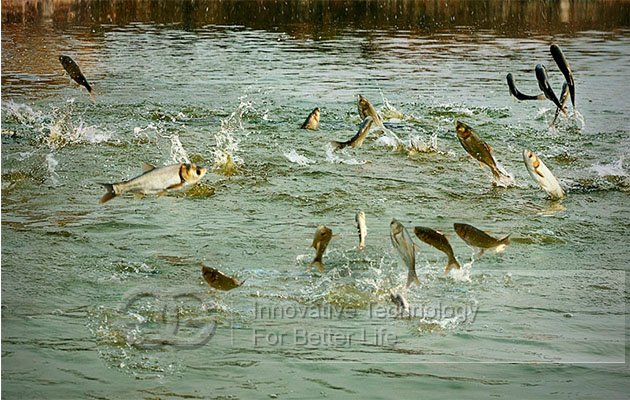- Prepare formulated fish feed pellet for tilapia
Time:2015-12-29
-
Feeding tilapia increased their growth, so that tilapia farming profitable. Therefore, farmers should prepare fish feed pellets must be nutritious and economical, it must be properly managed.The tilapias of North Africa are the most important commercial cichlids. Fast-growing, tolerant of stocking density, and adaptable, tilapia species have been introduced and farmed extensively in many parts of Asia and are increasingly common aquaculture targets elsewhere. The nutrients needed by tilapias include carbohydrates, fats, protein, vitamins and minerals. Other components of feed are fibre and moisture. For tilapia fish feed must contain all the nutrients in the right proportions to bring about growth.
 Prepared (artificial) Tilapia DietsFormulated feed for tilapia should contain between 27% and 40 % protein.For fry and fingerlings, the feed should have small particles and a protein content of about 35%- 40%, while for adults the protein content could be between 27% and 30%.Some farm-made feeds can have the following combinations.Powdered Leucaena leaves………20%Cooked maize……………………80%Rice bran…………………………70%Palm Kernel Cake…………………15%Maize meal/Cassava Dough……… 15%Tilapias, especially when reared in high densities, require a high-quality, nutritionally complete, balanced diet to grow rapidly and remain healthy.
Prepared (artificial) Tilapia DietsFormulated feed for tilapia should contain between 27% and 40 % protein.For fry and fingerlings, the feed should have small particles and a protein content of about 35%- 40%, while for adults the protein content could be between 27% and 30%.Some farm-made feeds can have the following combinations.Powdered Leucaena leaves………20%Cooked maize……………………80%Rice bran…………………………70%Palm Kernel Cake…………………15%Maize meal/Cassava Dough……… 15%Tilapias, especially when reared in high densities, require a high-quality, nutritionally complete, balanced diet to grow rapidly and remain healthy. Tilapia Feed TypesFormulated or compounded feeds may be given to tilapia in the dry, moist or wet form. Dried compounded feeds can be presented to tilapia as powder, pellets, or crumbles. Pellets are most popular and their shape and size would depend on the age of the tilapia.Commercial fish feed pellets are manufactured as either extruded (floating or buoyant)or pressure-pelleted (sinking) feeds.Both floating and sinking fish feed pellets can producesatisfactory growth, but some fish species prefer floating, others sinking. Floating fish feed pellets are desirable for tilapia which feed from the surface layers of water.
Tilapia Feed TypesFormulated or compounded feeds may be given to tilapia in the dry, moist or wet form. Dried compounded feeds can be presented to tilapia as powder, pellets, or crumbles. Pellets are most popular and their shape and size would depend on the age of the tilapia.Commercial fish feed pellets are manufactured as either extruded (floating or buoyant)or pressure-pelleted (sinking) feeds.Both floating and sinking fish feed pellets can producesatisfactory growth, but some fish species prefer floating, others sinking. Floating fish feed pellets are desirable for tilapia which feed from the surface layers of water.
Extruded feed pellets are more expensive due to the higher manufacturing costs. Usually, it is advantageous to feed a floating (extruded) feed, because the farmer can directly observe the feeding intensity of his fish and adjust feeding rates accordingly. Determining whether feeding rates are too low or too high is important in maximizing fish growth and feed use efficiency. With a fish feed pellet extruder, you can make floating fish feed pellets conveniently from common materials at low cost.
Feed in a variety of sizes ranging from fine crushed material is large (1/2 inch or larger) particles small tilapia. About 20-30% of the size of the pellets should tilapia mouth gape size. Fed small particles can lead to inefficient feeding, because more energy in finding and eating more pellets. Instead, the particles will be too depressed farming, in extreme cases, can cause choking. Select the large size of the feed tilapia will actively eat.
Follow us





